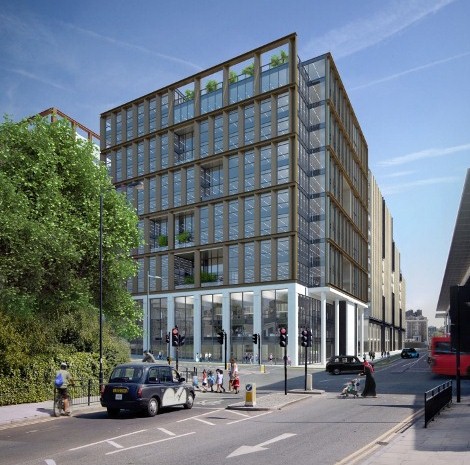Highest rated BREEAM Bespoke Building in the UK at 97.5% rating achieved
Project Details
- Scheme & Version: Bespoke BREEAM 2008
- Stage: Final
- Location: Location
- Size: 22,214m2
- Score & Rating: 97.5% Outstanding
- Certificate Number: BREEAM-0057-8260
- BREEAM Awards Winner 2013
Related links
Project Team
- Client: London Borough of Camden
- Developer: King’s Cross Central General Partner Ltd.
- Contractor: Kier Construction
- Architect: Bennetts Associates Ltd and LA Architects Ltd
- Building Services: Grontmij Ltd.
- Structural Engineer: AKT II
- BREEAM Assessor: Grontmij Ltd
- Quantity Surveyor: Davis Langdon LLP
Environmental features
- connection to the King’s Cross (CHP) Energy Centre providing low carbon heating and electricity to the building
- a commitment to achieve very high standards of environmental awareness on-site during construction
- use of ‘responsibly sourced’ materials
- a commitment to minimise construction waste and divert a proportion of the waste from landfill
- extensive consultation with the public, stakeholders, local authority, security consultants and access consultants to help steer the design process
- steps taken in the facade design to maximise daylight factors throughout the occupied areas, and to minimise artificial lighting requirements through adopting daylight linking/dimming
- a prime location with access to numerous transport nodes (King’s Cross Station, King’s Cross St Pancras, King’s Cross Underground, local bus network etc)
- significant cycle storage throughout the King’s Cross Central development, with the BREEAM requirement for cycle storage exceeded through storage adjacent to the building in the basement and at ground floor
- extensive sub-metering throughout the building to monitor energy and water use
- photovoltaics to achieve zero carbon status.
- a strong emphasis on passive design solutions
Building Services
The building will connect to the King’s Cross Central low carbon district heating network, distributed from a combined heat and power energy centre. This will provide all of the low temperature hot water requirements to heat the building and its domestic hot water systems. The leisure centre areas are comfort cooled via an all air system. The offices, library and access centre are served via a number of air handling units to provide a ‘zoned’ displacement ventilation system, responding to changes in occupancy and orientation.
The building’s cooling will be provided via ultra-high efficiency air cooled chillers located at roof level. These chillers are operated to meet maximum efficiency via an intelligent multi-sequencing controller. This will allow part-load running of two or more chillers to meet desired loads in order to improve seasonal efficiency. The swimming pools in this building provide a steady heat load allowing the low carbon energy centre to operate for longer. This results in the generation of greater electricity offsets. The inclusion of photovoltaics at roof level enables the building to further benefit from renewable energy.
CLLR THEO BLACKWELL, CABINET MEMBER FOR FINANCE AT CAMDEN COUNCIL, SAID: ‘First and foremost this will be a fantastic new facility for residents which we are able to deliver at no additional cost to Council Tax payers. We are able to fund this new facility through selling old buildings which are expensive to maintain and inefficient to run. Through taking these actions and by moving to a building which is much more energy efficient, we will not only be able to achieve long-term financial savings but also be much more environmentally friendly. We are an important part of the major regeneration of King’s Cross. Construction of the new building has started and will be completed in 2014. It will be at the heart of King’s Cross, situated in Pancras Square alongside new shops, offices and open spaces.’
Green Management
- very low energy consumption
- higher density occupancy of building, including hot-desking
- reduction in paper filing from over 30km to a target of 4.5k, an average of 1.5m per member of staff
- improved recycling facilities within the offices
- improved parking for cyclists visiting public facilities
- improved facilities for employees cycling
- monitoring of the building during occupation against predicted energy use
- a robust life cycle cost profile enabling future costs to be better managed
- carbon emissions reduced by an estimated 64% compared to the operation of the current buildings, representing a saving of more than £500k per annum
- benefits to the local community from the decision to use apprentices, particularly those who live locally or have been trained in the King’s Cross Construction Training Centre.
CLARE HEBBES, PROJECT DIRECTOR AT KING’S CROSS, SAID ‘Receiving a BREEAM rating of “Outstanding” signifies our intent to be at the forefront of sustainable developers and we are delighted this has been recognised. The 14-floor building will boast a number of environmental features including angled cladding to give solar shading that controls heat gain, whilst allowing good natural light. The windows will be opened at night to naturally cool the building, while terraces and an atrium will let in good levels of natural light to the centre of the building. It will have a brown roof to enhance the biodiversity and assist with controlling peak storm water run-off and the performance and operation of the building will be carefully controlled and monitored by an intelligent building management system. Overall, the building will achieve carbon emissions that are 50% lower than required by the 2010 Building Regulations, ensuring that Camden Council’s building will be one of the greenest buildings in London and will achieve substantial and sustained savings in energy use and operational costs.’

